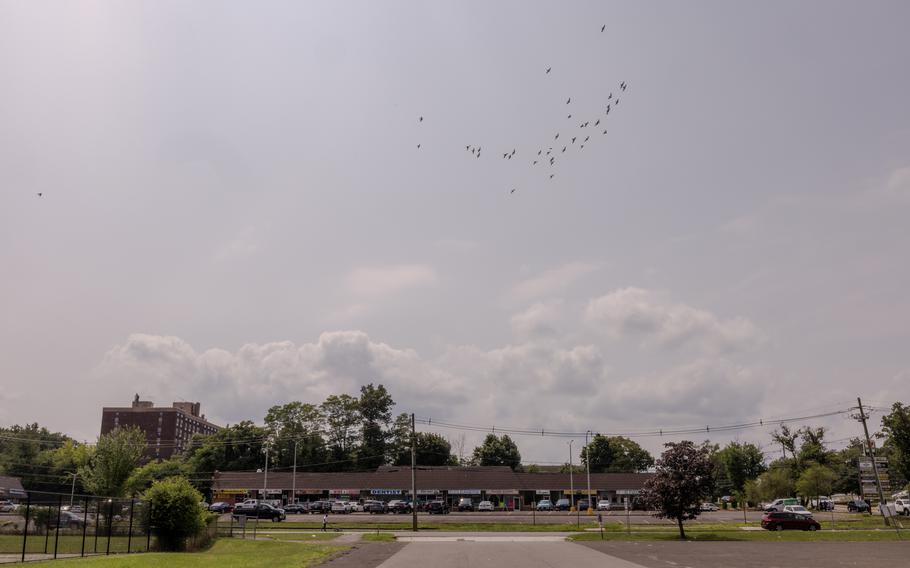
Spring Valley High School was among the schools in the East Ramapo Central School District that had tested positive for elevated lead levels in 2016. (Natalie Keyssar/The Washington Post)
SPRING VALLEY, N.Y. — When the state of New York became the first in the nation to require all public schools to test their drinking water for lead in 2016, Keyry Broncano learned that water drawn from 68 different taps at her high school contained dangerously high lead levels.
Then Broncano, at the time a high school junior, discovered that the water she’d been drinking since kindergarten in the East Ramapo Central School District, about an hour north of New York City, probably contained elevated lead levels: Water from 23 taps at her elementary school was found to contain at least 15 parts per billion of lead. At her middle school, 85 taps had high lead levels.
“I was like, ‘I think I’ve been drinking poison,’” Broncano said, recalling rushing home to explain the news to her mother, a Guatemalan immigrant.
It’s an experience that has been repeated in schools across the country since 2014, when a crisis involving lead in the water in Flint, Mich., prompted some states to adopt new testing requirements for schools and day care centers.
Whenever states, counties or school districts have decided to test the water in their schools, lead has often been discovered.
Many school buildings have aging infrastructure that is more likely to leach lead into the water. And children are the most vulnerable to the harmful effects of lead poisoning. But despite an increased awareness of the danger posed by lead in water, there is no national mandate that requires testing drinking water in schools and child care facilities. As of 2021, a report found that only 18 states and the District of Columbia had some kind of requirement for school testing.
Lead is one of the most common and best-known contaminants found in drinking water, particularly in cities where pipes made of the substance were not widely phased out until a 1986 ban. While some cities have embarked on massive programs to replace lead pipes that connect to homes and businesses, there has been less attention on schools.
Experts and advocates said that by not solving the problem of lead in drinking water in schools, government has failed at a core responsibility: providing its most vulnerable citizens with clean, safe drinking water.
“Schools are places for learning and not places for kids to end up with a substance that is going to damage their ability to learn and grow,” said Cyndi Roper, a Michigan-based senior policy advocate at the Natural Resources Defense Council, an environmental advocacy group. “We can do better. We must do better.”
Still, the Environmental Protection Agency is expected to release a new rule in October requiring utilities to test at all the elementary and child care facilities they serve and offering to test at middle and high schools within the first five years. The rule would not require schools to fix the water if the testing reveals elevated lead levels in it, said Bruno Pigott, the acting assistant administrator for the EPA’s Office of Water, who said federal law does not give the agency authority to order schools and child care facilities to clean up their water unless they have their own water systems.
After the high lead levels were discovered in 2016, East Ramapo Central School District shut down taps in all of its schools. Some water fountains were covered up with trash bags and tape. Children began bringing water bottles from home, and standing jugs of filtered water were placed in hallways along with cone-shaped paper cups for drinking.
Eight years later, the district has still not fixed its taps. Harry Grossman, a former school board member who retired in June after 10 years on the board, said the district did not have enough money to fix them and instead provided bottled water.
Anthony DiCarlo, who became superintendent of the East Ramapo Central School District in July, said that he plans to make “the health and well-being” of the school community his “first priority.” He said 18 lead-free water fountains and bottle filling stations are now being installed for the coming school year.
But the public school community has been skeptical; families said they have been told for years that the taps would get fixed. And many worry the damage from lead has already been done to their children.
“Ultimately, I don’t know if the lead affected my brain,” said Broncano, 23. “I don’t know the damage the school has done to me, and unfortunately I don’t think I’ll ever fully know.”

Keyry Broncano, a former East Ramapo Central School District student, was a junior when she found out the water at her high school contained elevated lead levels. The water at her former middle and elementary schools did, too. (Natalie Keyssar/The Washington Post)
Setting children up for success
Long-term lead consumption can have debilitating and lifelong effects on children, including brain and nervous system damage, slow development, and hearing, speech and behavior issues, according to the Centers for Disease Control and Prevention.
Lead exposure also poses risks during pregnancy because the highly toxic contaminant can pass from mother to fetus, seeping into the placenta and the fetus’s growing bones and teeth, permanently affecting development.
Depending on state law, children are typically checked for blood lead levels at 1 and sometimes at 2 years old at annual doctor’s checkups but not afterward. But blood tests don’t always tell the whole story: Because lead moves from blood into the bones within weeks, blood tests can identify recent lead exposure but not long-term damage.
Banku Jairath, a Pennsylvania-based pediatrician who has studied the effects of lead poisoning on children, said too many children suffer from the effects of lead. She pointed to a 2009 study that showed 20 percent of ADHD cases in U.S. children can be attributed to lead poisoning. In Flint, where roughly 100,000 residents were exposed to lead-contaminated water, a study published this year found an increase in special needs and decrease in math achievement in the children following the lead-tainted water scandal, as compared with similar children in other Michigan schools.
Health and environmental experts say fixing the water in schools is one of the most efficient solutions to lowering the dangers of lead. The water in one school building can affect hundreds or thousands of children, the segment of the U.S. population that is the most vulnerable to lead poisoning, in a place where they spend a significant amount of time as they grow up.
In Chicago, a study published in March found that more than two-thirds of children under 6 years old are exposed to lead in their drinking water. And in New Jersey, more than 2,800 children under 6 years old had blood lead levels above the state standard in 2022.
Lead seeps into water from pipes, plumbing and fixtures made at least in part of lead. The more corrosive the water, the more likely that it will erode the pipes, picking up more lead from them.
In 1986, Congress amended the Safe Drinking Water Act to ban the use of lead pipes in further construction but did not require that lead pipes be replaced, leaving many existing homes and buildings vulnerable to toxic water.
Studies show the communities that bear the brunt of lead-filled water are disproportionately low-income and non-White, concluding that the distribution of lead in drinking water is a product of systemic racism.
Two years later, Congress mandated that states set up lead testing and remediation programs for schools, but the NRDC soon concluded that few states were complying and fewer than 1 percent of child care facilities had tested their water. The mandate was found to be unconstitutional by a federal appeals court in 1996.
Congress has subsequently considered adopting a requirement but instead passed legislation that included only funding for voluntary testing of school water.
The Biden administration last year proposed replacing all remaining lead pipes in the United States - estimated at more than 9 million pipes - within 10 years, with some exceptions.
But lead service lines, which are a frequent cause of lead-filled water in homes, are often not the main source of lead in school water. In schools, lead often lurks in the building’s plumbing and faucet fixtures, tainting the water long after it leaves the public water utility’s treatment centers.
Despite all of the evidence, encouraging schools to test for lead is often a challenge. Many schools that do test often find lead and face blowback from the parents and community, disincentivizing testing, said David Masur of PennEnvironment, an arm of the nonprofit and advocacy group Environment America.
A Government Accountability Office report from 2018 found only 43 percent of school districts across the country had tested for lead in their water in the previous two years.
When Houston tested every school last year, the school district’s contractor found nearly a third had water samples with above 15 ppb lead.
In New York, testing found that 82 percent of New York schools had at least one tap containing 15 ppb lead or more, which is considered a dangerously high amount that requires treatment, according to a 2018 NRDC analysis.
In North Carolina, a testing effort from 2020 to 2021 of more than 4,000 child care facilities in the state found some child care centers were more likely than others to have positive lead tests in their water: those with old infrastructure, those that rely on private well water, and those that housed Head Start programs - a federal program for underserved children.
The revelations led to a state law last year requiring that schools test their water for lead, too.
“When they’re in school and supposed to be learning, we don’t want the water they’re drinking in school to be contributing to potential cognitive and behavior difficulties,” said Jennifer Hoponick Redmon, a senior environmental health scientist at RTI, a nonprofit research institute that is operating the state’s school testing mandate.
The patchwork of state testing has led some advocates to push instead for a national “filter first” policy, in which initial mass testing is skipped in favor of installing lead-filtering taps in schools en masse. They argue it is the quickest, cheapest way to ensure children get clean water, avoiding millions spent on testing and replacing plumbing. Michigan became the first state to adopt a filter-first policy in 2023.
“If I could instantly impose a new law and say every state had to take that route, I would do it,” said Jim Elder, a former head of the EPA’s drinking water office, known in the 1990s as the Office of Groundwater and Drinking Water, who believes the EPA should adopt a national testing mandate for schools.
But others worry that filters would not be maintained and periodically replaced, as is necessary for them to be effective. Christina Hecht, a senior policy adviser at the University of California Nutrition Policy Institute, said she also worried a filter-first approach might convince children and their parents to avoid drinking water as dangerous, even when - depending on the severity of the lead level - it may still be a healthier option than carbonated beverages.
Schools that receive federal funds to provide children free or reduced-price lunches have been required by the U.S. Department of Agriculture since 2010 to provide “potable water” during meals, but the agency hasn’t addressed lead as part of the requirement. USDA said in a statement that the EPA is in charge of the issue.
The EPA’s new proposal has been met with mixed reaction. While advocates said they were glad the federal government was taking steps to address the issue of water in schools, many said the new rule doesn’t go far enough because it would require testing only once within five years of adoption and only from five taps per school and two at day-care facilities.
“It makes me so upset,” said Danielle Land, a postdoctoral research associate at Michigan State University who studies the issue and works with Mona Hanna-Attisha, a pediatrician who helped expose the Flint crisis. “There’s a lot of loopholes.”
The EPA says it disagrees that sampling requirements should be expanded, saying the program would be designed to be a preliminary, not comprehensive, screening for lead.

In Ramapo, families with children in public schools have expressed skepticism that the water taps will be fixed. MUST CREDIT: Natalie Keyssar for The Washington Post (Natalie Keyssar)
East Ramapo
Ana Maeda, a parent chaperone of the East Ramapo Central School District’s marching band, said she was struck by a moment at an April performance for the American Cancer Society in Orangeburg, N.Y. After the performance, a small group of middle and high school students in the band spotted a water fountain. They gathered around it.
“How do you use it?” she remembered one student asking. “Don’t touch it; you’ll break it,” said another. “What do I press?” she remembered a third chiming in.
“They acted like a cave person that just discovered fire,” said Maeda, 30.
Their schools have not had working water fountains for the eight years since lead was found in the water, and the children were unfamiliar with how to use one.
The school district has 9,800 students - 96 percent of them Latino or Black - attending public schools, while an estimated 30,000 other children from an ultra-Orthodox Jewish community attend private religious schools.
Public-school parents have complained that parents who send their children to private schools won election to the school board and then starved the district of necessary funds. The school district has a state monitor, but the public school parents and advocacy groups have called for a broader intervention.
Nancy Bermon, a local Jewish resident who has advocated on behalf of the public-school families, called the water situation only one piece of the larger problem. “It’s a symptom of neglect,” she said.
A state-mandated survey of the condition of East Ramapo schools completed last year found that all 13 district schools had water taps that were nonfunctioning.
Many of the school buildings also don’t have central air conditioning, some parents said, so classrooms can get hot, making it even more important that students stay hydrated. Families described buying water in bulk so their children can take multiple bottles to school at a time, a heavy expense in their budgets. Some said their children had moments of lightheadedness in school, often after gym class when the school jugs were out of water.
“Water seems like such a basic human right,” said Kayla Hoke, 23, who attended the district from first grade through graduation. She said ceiling tiles sometimes fell down during class at schools with worn textbooks and equipment. “When we learned there was lead in the water it was kind of like ‘Okay, this was bound to happen.‘”
Documents show the district is using federal funds to renovate buildings and plans to replace all water fountains, though it is unclear whether the renovations will include lead filters. DiCarlo, who responded to a request for comment after this story was published online, said the district is spending $1.2 million in federal funds on the drinking water issue and also received a donation of 20 additional lead-free water fountains.
Terry Rodriguez, whose three children attended public schools in the district, said she felt as though she were living “back in the Martin Luther King days.”
“We’re being discriminated against,” she said.
Rodriguez said she was concerned enough over the issue that she had her children’s blood tested for lead several years ago. The tests revealed that her middle child, who is now 18, had elevated lead levels in her blood, though, she said, not so high as to be a serious worry.
“How many years and generations down did this lead problem persist?” Rodriguez said. “How many children actually have lead poisoning in their body and don’t even know it?”